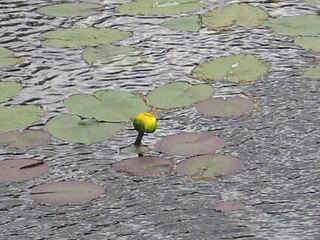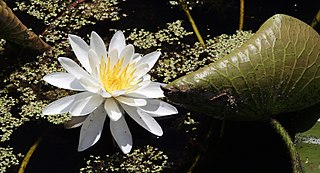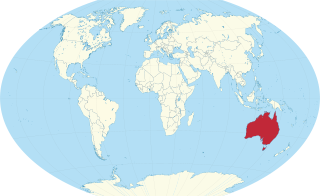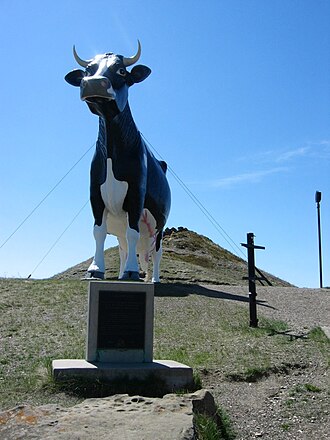
Nymphaeaceae is a family of flowering plants, commonly called water lilies. They live as rhizomatous aquatic herbs in temperate and tropical climates around the world. The family contains five genera with about 70 known species. Water lilies are rooted in soil in bodies of water, with leaves and flowers floating on or emergent from the surface. Leaves are round, with a radial notch in Nymphaea and Nuphar, but fully circular in Victoria and Euryale.

Nuphar is a genus of aquatic plants in the family Nymphaeaceae, with a temperate to subarctic Northern Hemisphere distribution. Common names include water-lily, pond-lily, alligator-bonnet or bonnet lily, and spatterdock.

Salem Sue is a giant fiberglass Holstein cow sculpture located in New Salem, North Dakota, United States. Salem Sue was built in 1974 for $40,000, by donations from local farmers and residents, and was sponsored by the New Salem Lions Club in honor of the local dairy farming industry. The artist was Dave Oswald, who is also known for designing the world's largest catfish, which sits in Wahpeton, North Dakota. The cow, which is hollow, was constructed by Sculpture Mfg. Co in La Crosse, Wisconsin and then transported in 3 parts before being put together. The statue stands 38 feet (12 m) high and 50 feet (15 m) long and weighs about 12,000 pounds (5,400 kg). It sits on School Hill near Interstate 94 off exit 127 S and can be viewed for several miles.

Nuphar lutea, the yellow water-lily, brandy-bottle, or spadderdock, is an aquatic plant of the family Nymphaeaceae, native to northern temperate and some subtropical regions of Europe, northwest Africa, and western Asia. This species was used as a food source and in medicinal practices from prehistoric times with potential research and medical applications going forward.

Neviusia alabamensis, the Alabama snow-wreath, is a small shrub which is native to the Southeastern United States.

Nymphaea odorata subsp. tuberosa is a subspecies of Nymphaea odorata native to the region spanning from Central and Eastern Canada, extending to North Central and Northeastern United States.

Neviusia, the snow-wreaths, is a genus of ornamental plants, which are native to the United States, containing two extant species and one extinct species known from fossil leaves. This genus is a rare example of a disjunct range occurring in North America. The type species, Neviusia alabamensis, occurs in several southeastern states, while second extant species, Neviusia cliftonii, is endemic to the Mt Shasta region of California, and the extinct species Neviusia dunthornei is found in shale deposits in the Okanagan Highlands of Washington and British Columbia. It is named for Episcopal priest and botanist Reuben Nevius.

The Allenby formation is a sedimentary rock formation in British Columbia which was deposited during the Ypresian stage of the Early Eocene. It consists of conglomerates, sandstones with interbedded shales and coal. The shales contain an abundance of insect, fish and plant fossils known from 1877 and onward, while the Princeton Chert was first indented in the 1950's and is known from anatomically preserved plants.
Diploporus is an extinct genus of conifers in the yew family Taxaceae, containing the single species Diploporus torreyoides known from the middle Eocene of north central Oregon and the Late Paleocene of south central North Dakota. The species was first described from a series of isolated fossil seeds in chert.

Euryale is a genus of flowering plants of the family Nymphaeaceae.

Shirleya is an extinct genus in the crape myrtle family, Lythraceae, which contains a single species, Shirleya grahamae. The genus and species are known from Middle Miocene fossils found in Central Washington.

Nuphar carlquistii is an extinct species of flowering plant in the family Nymphaeaceae related to the modern spatterdock, Nuphar advena. The species is known from fossil seeds and fruits found in the early Eocene Okanagan Highlands deposits of northern Washington state and British Columbia, Canada.
Concavistylon is an extinct genus of flowering plant in the family Trochodendraceae comprising a single species Concavistylon kvacekii. The genus is known from fossils found in Middle Miocene deposits of central Oregon. A second species "Concavistylon" wehrii was originally placed in Concavistylon, but subsequently moved to a new genus Paraconcavistylon in 2020.
The paleoflora of the Eocene Okanagan Highlands includes all plant and fungi fossils preserved in the Eocene Okanagan Highlands Lagerstätten. The highlands are a series of Early Eocene geological formations which span an 1,000 km (620 mi) transect of British Columbia, Canada and Washington state, United States and are known for the diverse and detailed plant fossils which represent an upland temperate ecosystem immediately after the Paleocene-Eocene thermal maximum, and before the increased cooling of the middle and late Eocene to Oligocene. The fossiliferous deposits of the region were noted as early as 1873, with small amounts of systematic work happening in the 1880-90s on British Columbian sites, and 1920-30s for Washington sites. A returned focus and more detailed descriptive work on the Okanagan Highlands sites revived in the 1970's. The noted richness of agricultural plant families in Republic and Princeton floras resulted in the term "Eocene orchards" being used for the paleofloras.
The Paleobiota of the Klondike Mountain Formation comprises a diverse suite of Early Eocene plants and animals recovered from North Central Washington State. The formation outcrops in locations across the north western area of Ferry County, with major sites in Republic, north west of Curlew Lake, and on the Toroda Creek area. The formation is the southern most of the Eocene Okanagan Highlands, sharing much of the paleoflora and paleofauna with site across Central and southern British Columbia.

Nymphaea carpentariae is a species of waterlily native to Queensland and Western Australia.
Barclaya motleyi is a species of perennial aquatic plant native to the region spanning from Thailand to Western Malesia, and New Guinea.
Barclaya kunstleri is a species of aquatic plant native to Peninsular Malaysia, and Singapore. It is disputed. By some, it is treated as synonym of Barclaya motleyi, but by others it is regarded as a separate species.

Nymphaea subg. Brachyceras is a subgenus of the genus Nymphaea.
Allenbya is an extinct genus of water lilies in the family Nymphaceae containing a single species Allenbya collinsonae. The species is known from permineralized remains recovered from the Early Eocene Princeton Chert in British Columbia, Canada.












